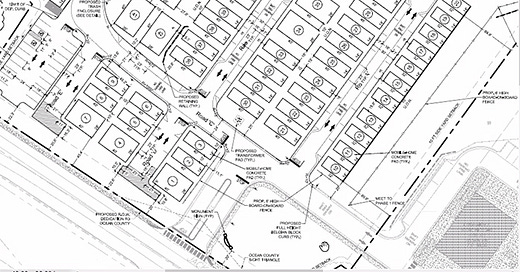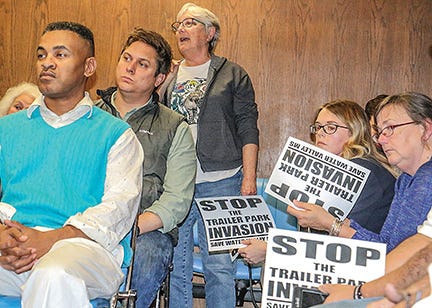Mobile Home Park Expansions
You might have seen a park listing with ‘expansion opportunities’.
Or maybe, your park has some vacant land in the back you’ve always wanted to infill with new homes.
Either way, expanding your park can be a bit, well….daunting.
Generally, we invest in fully built parks, which is clearly easier. But the more stabilized the park (full rents / full occupancy), the higher the price.
Or what if you’ve held a park forever and have run out of depreciation to offset your cash flow? This could be a great time to expand. Adding lots sure beats paying ordinary income taxes on rent.
Therefore, expanding a park is a great way to boost returns where you’ve already picked the low hanging fruit (bumping lot rent to market, sub-metering water, etc.)
Let me start by clarifying, we’re talking about park expansions on the CURRENT parcel with MHP zoning in place.
Buying, entitling and building an additional parcel is more complicated which involves zoning changes, city & county approvals, and some gentle sobbing.
Because if you have to change zoning, prepare to meet the NIMBY’s.
These people pulled up the affordable housing ladder behind them and are worried about “trailer park invasions”.
So new developments obviously have more risk (but higher return potential) than expansions that are already zone + permitted for the extra lots.
Before you consider breaking ground:
Is the existing park full? Bursting at the seams? Homes always rent fast, etc. This might seem obvious but we’ve seen underperforming parks try to expand for some unknown reason. This is like the loveless couple that decides to have a fourth kid to try and save the marriage.
How well capitalized are you? Can you withstand budget mistakes? Because guess what - one of the subcontractors will screw you. Death, taxes and subcontractor theft. It might even be legit - it’s hard to bid construction jobs - but the revised invoices will still fell like highway robbery. Make sure you have a big contingency line item.
Can the market support $500+ lot rents? Depends on the market so this is just a rough number, but since the land is already owned (expansion vs. new development) that should translate to a great un-levered return on per pad construction costs in most markets. It obviously varies wether your design includes gravel roads, 12 homes / acre and no landscaping (don’t do this) or concrete streets and gold plated community centers with pickle-ball courts and splash pads.
Will the expansion take a park to 100+ pads? This is a bit of a bonus as that is the minimum park size for a lot of private equity groups. It’s always good to have the largest potential buyer pool as possible. Even if the intent is to never sell.
Disclaimer - it should go without saying but every market will have different rules / regulations & costs. Don’t take the below as gospel.
Costs
Soft Costs
This includes anything not associated with the physical build out of the pads.
Site plan + layout design (reasonably price)
Full construction + engineering drawings (not cheap)
Topography analysis to access drainage
Environmental, traffic, etc. studies (depending on the city)
Extortion costs - aka any random fees the city wants to take from you
While these soft costs tend to be a fraction of the overall costs, they can rack up pretty quickly if you don’t use efficient + reasonable vendors.
Hard Costs
These costs make up the physical improvements to the park.
Tree clearing
Dirt work (surprisingly expensive)
Retaining walls - try to avoid, a good site plan can often find workarounds
Small bridges over streams - avoid, avoid, avoid
Drainage, culverts, etc.
Sewer lines, water mains and laterals to the homes (please don’t have these run under the homes).
Sidewalks (rolled curbs are cheaper, look great - full curb if going for 5 star look and feel)
Street lights
Electrical
We could go on, but you get the point.
You can also choose to build the pads & driveways at this time or some owners will wait until they start selling homes to pour concrete pads. Why? Well in some markets this might be an extra $10-$15K a pad.
Lining up these costs with actual home sales is a way to defer costs. A park owner also might be able to incorporate or finance some pad costs into a home sales package.
You can see why all this doesn’t work in $300 lot rent markets.
Conversely, if you’ve got a hot park with $600+ lot rents and room to expand - build baby build.
Hiring a Contractor
An experienced + reliable + trustworthy contractor is worth every penny, both in fewer headaches & speed of product delivery.
Don’t just hire the lowest bidder. There are a lot of jokers out there.
Confirm your contractor knows the local state requirements for new pads. Talk to the city building department to see if they like or hate your proposed contractor. They tend to know the pros and will make things difficult for the project if they think your guy cuts corners.
You just need extremely detailed people helping you.
The nightmare scenario is when you’ve budgeted a plan + design and are well into the process and find out the city will require something totally different.
Expansion Fail
One of our contractors poured a bunch of new concrete pads on an expansion, we shipped brand new homes to the park and paid to have them set.
But the city wouldn’t sign off on the home install permits (final step for occupancy).
They wanted 3 feet of extra concrete around the home.
What’s that now?
Unfortunately, this was news to our contractor + engineers and somehow never came up during the city’s lengthly review of the plans. Apparently there was miscommunication over the actual size of the homes we planned to install.
Who do you think ate the costs to move the homes, add rebar and pour more concrete?
All the vendors finger pointed the blame, but there was too much work left to do to fire them and fight over back invoices. We needed a motivated team to finish the job. We could have caught the error too, so we weren’t blameless.
Anyways, this wasn’t fun but it was only a minor cost overrun relative the overall budget. The expansion still worked out great.
But still, try to get the best vendors that have done this work before and also have great relationships with city officials. If their kids play on the same sports teams they’ll figure out a way to push things forward with reasonable solutions even if there are mistakes.
Construction is a lot different than buying and managing parks so get good help, get things in writing from the city, and make sure someone on the team is extremely detailed.
But mostly, just plan for screwups.
As always,
Happy Trails
MHP WEEKLY








